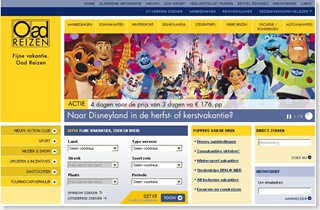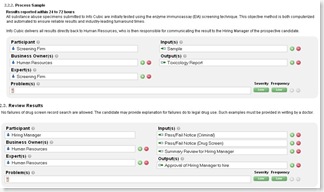
Ci rivediamo a Gennaio 2009.
Buone feste a tutti con l'augurio e la speranza di un bel 2009.

La maggior parte delle nuove applicazioni o gli aggiornamenti 
Con la situazionen di mercato attuale nessun azienda può accettare tempi così lunghi.
La soluzione è utilizzare strumenti BPM.
Sentite qui come due CIO (di SIRVA e NAACO) sono riusciti a ridurre drasticamente i tempi di sviluppo attraverso l'adozione di tecnologie BPM.

Il numero di novembre dicembre della rivista degli u

 Conversely, the business side sometimes has an unnatural understanding of what IT does. Most technical strategies are not for the business to drive and, in fact, by bringing the business to the table as part of these strategies, you bring into effect an unnatural alliance where natural departmental goals are subverted.
Conversely, the business side sometimes has an unnatural understanding of what IT does. Most technical strategies are not for the business to drive and, in fact, by bringing the business to the table as part of these strategies, you bring into effect an unnatural alliance where natural departmental goals are subverted.
 point del processo)
point del processo)




 iagram session including who needs to be involved and how to capture their knowledge.
iagram session including who needs to be involved and how to capture their knowledge.




Scrive Jim Sinur sul suo blog in Gartner:
"I was listening to the opening session at the Gartner Symposium, here in Florida, and there was a big theme around how to deal with the economic uncertainties we are seeing at the moment. One of the speakers said that it was time to delete applications as these are times to trim down and look for belt tightening opportunities It occurred to me that there are probably as many or more processes in an organization as there are applications once you drill down to a detail level.
Business process improvement efforts are often aimed at optimizing for cost savings within a process and/or innovative new processes, but there my gut tells me there are costs savings to be gleaned by getting rid of processes and/or standardizing on common processes. It also seems to me that some of the same application portfolio best practices could be applied to process in order to save money going forward. It’s pretty easy to do a high level process value evaluation and follow the scent of non value added sub processes a![]() nd look for processes to trim. This seems like an obvious place to start our cost savings journey needed going forward into 2009."
nd look for processes to trim. This seems like an obvious place to start our cost savings journey needed going forward into 2009."
Bene quale strumento migliore di Blueprint di Lombardi per fare questo inventario?
Provatelo gratis qui.
Il 14 ottobre ci sarà la possibilità di partecipare ad  un webinar presentato da Phil Gilbert, attualmente President di Lombardi Software e precedentemente CTO e creatore di Teamworks e Blueprint.
un webinar presentato da Phil Gilbert, attualmente President di Lombardi Software e precedentemente CTO e creatore di Teamworks e Blueprint.
Phil, come è noto ai lettori di questo blog, conduce un suo interessante blog a cui potete accedere da qui.
Nella sua presentazione Phil parlerà delle difficoltà per passare da un progetto BPM alla sua effettiva realizzazione.
A tutti gli iscritti verrà inviato il documento “3 Steps for Moving from BPM Projects to BPM Programs”, con i dettagli sui tre passi necessari per costruire delle solide fondamenta per lo sviluppo di applicazioni BPM.
Per registrarsi cliccate qui
I webinar si terrà alle ore 18 italiane e durerà 35 minuti.
Sandy Kemsley sta partecipando al BPM Think Tan k a Chicago e sul suo blog sta pubblicando una cronaca in tempo reale.
k a Chicago e sul suo blog sta pubblicando una cronaca in tempo reale.
Per seguire il meeting cliccate qui
In un momento economico paricolarmente complesso il rimanere competitivi è molto di più di una scelta aziendale può voler di re soppravvivere o scomparire.
re soppravvivere o scomparire.
Dice Jo Hoppe su E-week.com : "
To remain competitive in today’s rapidly changing business climate, the agile enterprise must be able to introduce new applications to automate manual processes quickly and effectively. But making a build or buy decision is often as time-consuming as the process of getting the new application up and running. Business Process Management is an alternative that can be leveraged to develop applications faster and cheaper than traditional methods."
Leggete l'articolo completo qui
Come rimanere competitivi? build, buy or BPM
Search CIO.com, una rivista di IT managementche si rivolge ai CIO, ha pubblicato un bell'articolo dal titolo:
CIO.com, una rivista di IT managementche si rivolge ai CIO, ha pubblicato un bell'articolo dal titolo:

Nell'articolo sono citate le esperienze di due utilizzatori di Lombardi-Teamworks: NACCO Group e Wells Fargo.
Particolarmente interessante quanto affermato da Bob Shallow sulla scelta di sviluppare in Teamworks un sistema PLM (Product Lifecycle Management) invece che acquistare una piattaforma dedicata. In particolare si dice:
"The decision has paid off: Shallow has completed many projects successfully and quickly. The first one -- a process redesign to automate a small cost authorization system -- took just 15 days" e
"SOA isn't a factor right now. "It's too far in the future to predict. We have tons of processes that we can improve leveraging our existing systems and the BPM tool"
Nello stesso articolo Wells Fargo segnala anche:
“... a recent BPM project for the centralized loan disposition group resulted in savings of $250,000 pretty quickly”
Per leggere l'articolo completo cliccate qui.
Mi vengono spesso richieste informazioni sui corsi necessari per imparare ad utilizzare Teamworks; questi sono i corsi di formazione oggi disponibili.
I corsi attualmente sono tenuti solo nelle sedi di Londra e Austin. Se siete interessati a conoscere le dati contattatemi.
Teamworks Modeling Processes
This 4-day course will teach participants how to model and implement business processes with Lombardi Teamworks. It demonstrates how Teamworks can support different modeling goals using actual business processes as examples.
Teamworks Implementing Processes
This 2-day course covers the development of Teamworks services. Topics such as managing variables in Teamworks, creating services for integration with external applications, and handling exceptions will be covered. During the course, participants will have various labs that reinforce course topics.
Teamworks Operations, Administration, and Management
This 3-day course covers the operations, administration and management of Teamworks 5 and 6.
Teamworks Optimizing Processes
This 1 day course covers optimizing processes in Teamworks. Using an existing Teamworks BPD (Business Process Diagram), students will configure, interpret, optimize, and simulate processes. Once complete, students will have an optimized Teamworks BPD.
Teamworks di Lombardi è stato scelto da uno dei più gr ossi tour operator olandesi per gestire i loro processi mission-critical "sales" e "logistic".
ossi tour operator olandesi per gestire i loro processi mission-critical "sales" e "logistic".
Leggete qui il comunicato stampa
Jim Sinur dopo un breve periodo in Global360 è tornato in Gartner dove ha iniziato a tenere un blog sul BPM.
Per vederlo cliccate qui.



L'applicazio![]() ne Lombardi SaaS per il BPM discovery è stata nuovamente aggiornata.
ne Lombardi SaaS per il BPM discovery è stata nuovamente aggiornata.
La nuova versione è stata migliora ta nelle performance mentre è stata riscritta la parte relativa alla documentazione dei processi permettendone ora una vista più strutturata.
ta nelle performance mentre è stata riscritta la parte relativa alla documentazione dei processi permettendone ora una vista più strutturata.
Vi ricordo che la prova di Blueprint è gratuita e in questa nuova versione la procedura di primo login è stata semplificata al massimo.
 Ora in 20-30 secondi si è in condizione di utilizzare il sistema.
Ora in 20-30 secondi si è in condizione di utilizzare il sistema.
Si sta svolgendo in questi giorni a Milano presso il  Politecnico il 6° International Conference on BPM.
Politecnico il 6° International Conference on BPM.
Cliccate qui per accedere al sito.
Chi è impossibilitato ad esserci può leggere una cronaca degli inteventi sul blog di Sandy Kemsley cliccando qui.
Nel prossimo Gartenr Business Process Mana gement Summit (dal 10 al 12 settembre a Washington DC) due utenti di Teamworks presenteranno le loro esperienze.
gement Summit (dal 10 al 12 settembre a Washington DC) due utenti di Teamworks presenteranno le loro esperienze.
Mr. B ob Shallow, direttore delle sviluppo alla NACCO Materials Handling Group parlerà sul tema "Gaining Adoption for Your BPM Initiative" mentre Mr. Gene Rawls, vice-president of continous improuvment in Wells Fargo parlerà sul tema "How Wells Fargo Built a Cross-Organizational BPM Capability" .
ob Shallow, direttore delle sviluppo alla NACCO Materials Handling Group parlerà sul tema "Gaining Adoption for Your BPM Initiative" mentre Mr. Gene Rawls, vice-president of continous improuvment in Wells Fargo parlerà sul tema "How Wells Fargo Built a Cross-Organizational BPM Capability" .
Bob Shallow sarà anche ospite in un web-seminar dallo stesso titolo il 16 settembre alle 18 ora italiana. Per iscriversi cliccate qui
Nel corso del Summit parlerà anche Toby Cappello, direttore dei professional service in Lombardi con un intervento dal titolo "Breaking Down the Three M ajor Barriers to BPM Success" mentre Phil Gilbert come presidente e chairman del comitato "BPM Standards" in OMG (Object Management Group) parlerà sul tema "Governing An Enterprise-Wide BPM Program"
ajor Barriers to BPM Success" mentre Phil Gilbert come presidente e chairman del comitato "BPM Standards" in OMG (Object Management Group) parlerà sul tema "Governing An Enterprise-Wide BPM Program"
Per vedere il programma completo del meeting cliccate qui
Malgrado il periodo di stagnazione dei mercati, Lombardi ha raggiunto nel primo semestre 2008 una crescita di fatturato di più del 50% rispetto allo stesso periodo dell'anno scorso.
I nuovi clienti includono Ayudhya Allianz C.P. (Thailand), Allianz Hungaria Biztosito Zrt., Charles Schwab, G&D Integrated, Jaguar Land Rover, Maritz Research, Massachusetts Department of Revenue, Merchant Investors Assurance Company Ltd., OAD Groep BV, Savvis, Singapore Refining Company Private Limited, TeliaSonera, Wells Fargo Home and Consumer Finance Group, Wirtualna Polska SA e Yale University.
Riprendo dal comunicato stampa Lombardi il Summary
A summary of Lombardi's results from the six months ended June 30, 2008 include the following:

For their recent InformationWeek Analytics 2008 Tomorrow’s CIO Survey, the well-known trade publication quizzed 720 corporate managers, including CEOs, CFOs, and COOs, as well as CIOs and VPs of IT-level executives, about the attributes most desirable for future business technology leaders. IW’s John Soat then posted an excellent write-up of the survey’s findings, and I’ve been thinking about it ever since. John writes:“Whether they know it or not–and most do–companies need an executive leader well versed in both technology and business processes. The CIO position is tailor made to take that role. . .the question is, which CIOs will step up to it?”
This chart (also below) based on the survey’s findings isn’t surprising if you’ve been looking at things from a process point of view as long as we have, but it’s not trivial that respondents noted “Need to manage or optimize business process” as the #1 priority as the CIO continues to strive to become more of a business leader.

Jon also writes:
“A similar question, with a similar response, was this: ‘What do you see as the main opportunities before CIOs today?’ The No. 1 answer by both CIOs and corporate managers is ‘improve and/or innovate new business processes’. . . the CIO’s overview of corporate-wide systems and applications gives the CIO as deep and encompassing an understanding of the organization’s business processes as any executive, on par with that of the CEO and CFO. It makes sense that the CIO would seek–and be called on–to leverage that process expertise.”
Let’s go a little further though, because insofar as process excellence is top-of-mind, what exactly is driving this focus on business-side leadership?
The evolving role of the CIO (and by extension the IT organization itself), of course. The fact of the matter is that any true executive leader will be fluent in both technology and business principle – and the processes that govern the cross-functional nature of today’s leading companies.
As always, technology leadership remains important – the ability to look into the future and understand which technologies will have strategic value and ongoing impact is a necessary skill. But today, business-side savvy is equally important, a fact that Harvey Koeppel, executive director of the Center for CIO Leadership, echos in the article, explaining that for CIO’s, “speaking the language of the C-suite, development of one-to-one relationships, and driving the agenda” are paramount, because “[CIO’s are] at the center of the most important trends in business today.”
And InformationWeek isn’t the only place where this trend is being put front and center. In April, IT Week (UK) wrote a great piece summarizing Gartner’s 2008 worldwide survey, which likewise determined that BPM has become CIO’s top priority.
We at Lombardi are proud of our leadership position in BPM, in no small part because we have been aggressively talking about business-focused technology and cross-functional roles since the very beginning. We haven’t shied away from explaining why BPM will become the focus of solution engineering at enterprises large and small.
As technology continues to underwrite the business in an ever-more fundamental sense, we’ll continue to see process take center stage. The question I have for our readers though is – although the trend isn’t exactly anything new, has BPM indeed gone mainstream? Are you approaching the same tipping point at your company?
Questo è l'interrogativo che si pone ComputerWordl Italia nell' articolo che potete leggere qui.
Nell'articolo viene citato uno studio di R&S Mediobanca su come sono cresciuti i guadagni per impiegato nel mondo bancario dal 1998 al 2006.
Ecco i dati che reputo sicuramente allarmanti anche se, per chi opera nel mercato italiano, non sono certo una novità.
Spagna: + 53,5 %
Germania: + 56,2 %
G. Bretagna + 71,3 %
Europa + 43,2 %
USA + 30,0 %
Italia + 6,1 %
